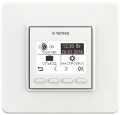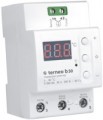Connection
How to connect the controller to the controlled device.
—
Wired. Connecting with wires is the most common option. It is due to its main advantages — simplicity, reliability and low cost. On the other hand, the wiring itself can be quite troublesome and time-consuming.
—
Wireless. Wireless connection — usually by radio channel. To do this, the kit usually provides an external transceiver connected to the controlled device. The main advantage of wireless models is obvious — they are much easier to install because no need to run extra wires. On the other hand, such a technique is much more expensive than wired, and communication has a limited range, which is further reduced if there are obstacles (such as thick walls) in the signal path.
—
DIN rail. The phrase "on a DIN rail" traditionally refers to the method of installing the device (see "Mounting"); the connection is usually carried out by wire. However, this option is taken out separately for the reason that DIN devices are standardly mounted in a distribution cabinet — unlike conventional wired
thermostats, installed directly in the room. However, sometimes it is an advantage: the distribution cabinet can be locked with a key, restricting unauthorized access to the thermostat. Models with such a connection usually refer to professional equipment used in industrial
...facilities, warehouses, etc.Mounting
The way to install the thermostat.
—
Into mounting box. Installation in a standard junction box. Simply put, the regulator is mounted into the wall in the manner of a conventional switch or socket (most often even the mounting dimensions are the same, although there are exceptions). For installation, most likely, you will have to work with a rotary hammer, but the device will be securely fixed and at the same time will take up a minimum of space.
—
On wall. These thermostats usually have a flat shape with a small thickness. Wall mounting is easier than embedding, but somewhat less reliable — in case of an unfortunate set of circumstances, the device can be hit and seriously damaged.
—
To boiler. Installing a thermostat directly on the boiler. This option is traditional for devices used in solid fuel boilers (see "Type") that control combustion through a chain connected to an air damper, but it can also be found in other types of regulators — for example, designed for gas boilers. In the first case, this method of installation is due to the design features of the device (see "Chain length"). In the second case, installation on the boiler simplifies the design and installation, but at the same time makes the regulator not very convenient: on the one hand, the design does not have a remote unit, the connection of which is associated with certa
...in troubles, on the other hand, you will have to approach each time to adjust the thermostat. to the boiler, which is not always convenient.
— DIN rail. Mounting on a special metal rail, which can also be used for electrical grounding. Such rails are commonly used in distribution boards. Most often, this installation method is used in industrial equipment, although it can also be useful for residential premises. Note that there are several types and sizes of DIN rails. Therefore, before buying a regulator with such an installation, it is highly desirable to clarify its compatibility with the seat.
— Portable. Devices that do not require permanent installation in the same place. By definition, they use a wireless connection (see above). Most often, portable thermostats are equipped with stands for installation on a table or other flat surfaces and are designed more for desktop use than for the role of a portable remote control. Nevertheless, the design makes it easy to move such a device from place to place, which can be useful, for example, in a large house, where you have to be in different places at different times and it would be inconvenient to run to the wall or built-in thermostat every time. Among the disadvantages of portable thermostats, one can mention the rather high cost and the need to use a battery (respectively, a limited operating time).
— In socket. Thermostats plugged into a regular household outlet. Usually, such devices have their own socket on the case and play the role of an adapter switch through which an electric heater (or other device) is connected to the network. With this connection, the thermostat controls the power coming from the outlet: turns it off when the required temperature is reached and turns it on when necessary. Such devices are extremely easy to install. Moreover, they are easily rearranged from outlet to outlet. On the other hand, the very location of the thermostat is not very convenient — sockets are often located in hard-to-reach and not the best places for a temperature sensor.Max. load
The maximum load in terms of current power that the thermostat can withstand. In other words, the maximum electrical power that it can pass through itself without failures and damage.
The choice for this parameter directly depends on the power consumed by the boiler or heater connected through the thermostat; load limitation is of particular importance when working with electric boilers, the energy consumption of which is measured in kilowatts. When connected directly, the power of the heater should not exceed the maximum load of the thermostat, otherwise the latter will simply fail. However, when using additional protective devices (contactors), many models allow connection to a more powerful load than originally allowed.
Temp adjustment range
It is the range in which the air temperature can be set on the regulator. The choice for this indicator depends on the expected conditions in the room. So, in a residential building, the lower temperature limit at the level of 5–10 °C is quite sufficient; the upper limit is within 30–40 °C (regardless of whether we are talking about air or floor temperature). But in control devices designed for industrial use, this range will be much wider — from sub-zero temperatures to the upper limit of 100 – 125 °C.
Air temp sensor
The presence
of an air temperature sensor in the design or delivery set of the controller — such a sensor can be either built into the device or external.
Air temperature is one of the key parameters that determine the climate in the room and the comfort of staying in it. Accordingly, the air temperature sensor allows the regulator to evaluate the general conditions in the room and control the heating operation, taking into account how the microclimate corresponds to the desired one. However, note that such sensors are not always applicable. For example, in kitchens and bathrooms, they may not work correctly (when hot water, a gas stove or a water heater is turned on, etc.), so in such conditions it is better to use floor temperature sensors (see below).
Sensor cable length
The length of the supplied cable in the wired thermostat sensor (see "Type"). The longer the cable, the further the temperature sensor can be installed from the device. At the same time, the principle “the more the better” is quite relevant: excess wire usually does not create any special problems, but if the length is insufficient, you will have to lengthen the cable, or even purchase another sensor.
Note that in modern models, the cable length usually does not exceed 4 m — this is usually enough when installing a thermostat in the same room but with the removal of the device outside the room, difficulties may already arise.
Timer type
The type of timer provided in the design of the thermostat. In this case, a timer means a scheduler that allows you to programme different operating modes for different periods (for example, lower the temperature at night and increase it by the time you get up). Such schedulers are divided into types depending on the time covered.
—
Daily. The timer allowing to set the programme within 24 h; then the programme will be repeated every day. This variety is the simplest and, as a result, inexpensive. On the other hand, for most users, the daily routine on weekdays and weekends are noticeably different, and, most likely, the timer will have to be reprogrammed at least twice every week — before the weekend and at the end of the weekend.
—
Weekly. A timer that allows you to set a work programme for certain days of the week. The simplest varieties of such schedulers work according to the “5 + 2” scheme: one programme is set for 5 working days, the other for 2 days off. However, there are more advanced options — up to the ability to programme each day of the week separately. Anyway, weekly timers are more convenient and require less reprogramming than daily timers but they are much more expensive.
Programmable cycles per day
The largest number of individual cycles that the thermostat timer can set in one day.
The cycle is the period during which the thermostat operates on one set of settings. For example, if there are 2 cycles, you can provide turning off the heating while you are at work and turn it on shortly before returning home. However, most thermostats provide a noticeably larger number of cycles — up to 24.
Note that in weekly timers (see "Timer type") this parameter may differ depending on the day of the week. For example, weekdays usually have more extensive settings than weekends.
Minimum increment
The shortest duration a programmable thermostat cycle can have (see "Programmable cycles per day").
The lower this parameter (with the same number of cycles per day) — the wider the possibilities for programming the operation of the thermostat, in particular, for its specific setting (for example, you can provide a short period of preliminary "intensive heating" after working at low temperatures). On the other hand, due to a certain inertia in the operation of heating systems, it makes no sense to make an interval shorter than 10 minutes — the thermostat simply does not have time to work out the specified settings in less time. And in the most "long" models, this parameter is about 30 minutes.

